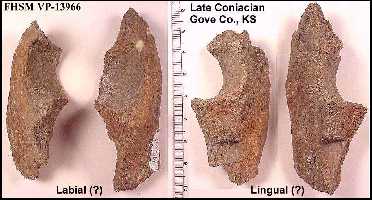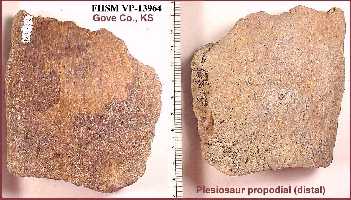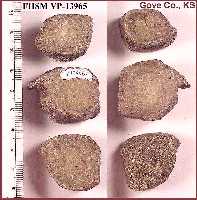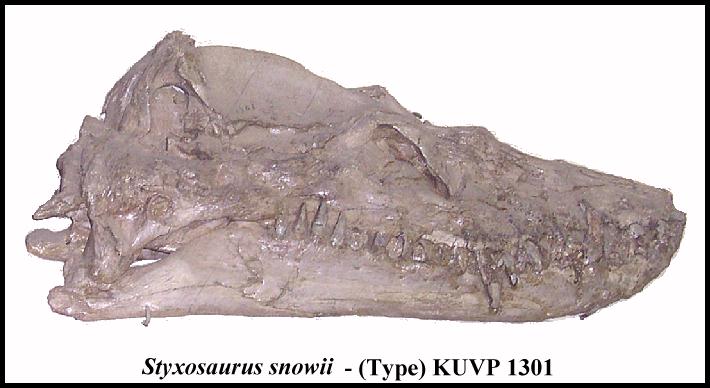 |
KANSAS PLESIOSAURS
A
chronological guide to the Cretaceous plesiosaurs of Kansas from Albian through Middle
Campanian time (110-75 MYA).
Copyright ©
2004-2013
by
Mike Everhart
Page
created 10/03/2004 - Last updated 11/10/2013
LEFT:
The only elasmosaur skull known from the Late Cretaceous of Kansas. Currently on
exhibit at the University of Kansas Museum of Natural History, Lawrence, KS. |
Kansas has a very complete, if somewhat poorly-recognized, fossil record of the
nearly continuous presence of plesiosaurs from the last part of the Early Cretaceous (110
mya) to almost the end of Late Cretaceous (75 mya). There are at least six
valid type specimens named from plesiosaur remains found in Kansas. Most of the
other "species" named since 1873 have been found to be "indeterminate"
(lacking enough material to adequately justify naming a species) by Welles, Carpenter and
Storrs.
Plesiosaurs were among the first vertebrate fossils found in Kansas. The first
elasmosaur (Elasmosaurus platyurus) was found in the
Pierre Shale of western Kansas in 1867, followed by the discovery Polycotylus
latipinnis in the Smoky Hill Chalk in 1869. Both were initially described and named by
E. D. Cope. Professor B. F. Mudge found plesiosaur remains (KUVP 1325) in Russell County
in 1873, but believed they were those of an
ichthyosaur. It was later named Trinacromerum
“anonymum” by 1873 (Williston, 1903), and then determined to be a
junior synonym of T. bentonianum by Carpenter (1996). Mudge also found the
only elasmosaur known from
the Fort Hays Limestone (Elasmosaurus nobilis; YPM
1640) in Jewell County in 1874 (Williston 1906). Three other "elasmosaurs" (YPM
1644 and 1130, and KUVP 434) were found in Wallace County (which then included present-day
Logan County) between 1874 and 1876. All were briefly described by Williston (1906).
The first specimen of a pliosaur from Kansas (Brachauchenius
lucasi; USNM 4989) was found in Ottawa County about 1884 by John Potts. It
was collected by C.H. Sternberg for O.C. Marsh and later acquired by the Smithsonian Institution.
It was subsequently described by
Williston (1903) along with a second specimen from Texas. A third and much larger
skull (FHSM VP-321) was collected by George Sternberg in Russell County in 1950. Another
polycotylid, Trinacromerum bentonianum, was first described by Cragin (1888,
1891) from two partial skulls (USNM 10945 and 10946) collected from the "Fort
Benton" of Osborne County. Both specimens are now in the collection of the
Smithsonian Institution. The nearly complete skeleton of a third species of
polycotylid, Dolichorhynchops osborni (KUVP 1300), was discovered by George
Sternberg as a teenager in 1900 and also described by Williston (1903). George Sternberg
found a second specimen of Dolichorhynchops in 1926. It was eventually
acquired by the Harvard Museum of Comparative Zoology and curated as MCZ 1064. The Dolichorhynchops specimen (FHSM VP-404) at the Sternberg Museum was discovered by
Marion Bonner about a mile SW of Russell Springs (Logan County), Kansas.
Plesiosaurs are rare in the Dakota
Sandstone. This is
reasonable because the Dakota Sandstone was laid down in fresh water as part of a huge
delta of a large river or rivers flowing into the Western Interior Sea from the
northeast. The fossils found in it (leaves, dinosaurs, crocodiles, track ways, etc)
represent a terrestrial environment for the most part. However, since the river was
flowing into the sea, and sea levels were rising at the time, one might expect marine
fossils to occur there occasionally. In fact, a diverse near-shore marine fauna was
reported from the upper Dakota Sandstone by Everhart and Ewell (2004). In addition,
I saw the remains of a plesiosaur (vertebrae) discovered near Kanopolis Lake (Ellsworth
County) in 1968, and the Sternberg Museum has a plesiosaur specimen (FHSM VP-2151) collected from the Dakota Sandstone
of Stanton County in 1963. However, there have been no plesiosaurs described to date from
the Dakota Sandstone in Kansas.
In 1894, Cragin described the first
plesiosaur from the Kiowa Shale (upper Early Cretaceous; Albian age) of southern Kansas
(Kiowa County). The composite specimen consisted of vertebrae and limb elements and was
named "Plesiosaurus mudgei." Williston (1897) named another species (Plesiosaurus
gouldii; KUVP 1306) from a specimen found in the Kiowa Shale of Clark County.
Williston (1903) also figured another specimen of P.
mudgei (KUVP 1305) that was collected in Clark County by C. N. Gould in 1893.
This specimen originally consisted of a limb bone, vertebrae and about 200
gastroliths. Only three vertebrae remain today. It is unlikely, according to
Williston (1903), Welles and others, that these remains belong in the genus Plesiosaurus
but they are so incomplete and poorly preserved as to preclude further identification. The
Sternberg Museum has additional plesiosaur remains collected from Clark County, and I have
seen fragmentary remains and teeth that were collected from the Kiowa Shale near Marquette
(McPherson County) in central Kansas.
The American Museum of Natural
History (AMNH), Cincinnati Museum Center (CMC), Fort Hays State University Sternberg
Museum of Natural History (FHSM), University of Kansas Museum of Natural History (KUVP),
Los Angeles County Museum of Natural History (LACMNH), Harvard Museum of Comparative
Zoology (MCZ), New Jersey State Museum (NJSM), University of Nebraska State Museum (UNSM),
United States National Museum (USNM - Smithsonian) and Yale Peabody Museum (YPM) have
important Kansas plesiosaur specimens in their collections.
LATE CRETACEOUS (99 to 75
MYA in Kansas)
| Approximate Age |
Formation |
Specimens (includes type and various indeterminate
specimens - list is not complete) |
| Middle Campanian |
Sharon Springs Fm., Pierre Shale |
Elasmosaurus platyurus (ANSP 10081 - Type; FHSM
VP-398; KUVP 129744; CMC VP6865); Styxosaurus snowii (NJSM 15435and CMC 2023);
Elasmosauridae indeterminate; Dolichorhynchops osborni |
| Early Campanian |
Smoky Hill Chalk |
Styxosaurus snowii (Type - KUVP 1301);"Elasmosaurus
sternbergi" (KUVP 1312); Two indeterminate elasmosaurids (YPM 1130, KUVP 434);
Polycotylus latipinnis (USNM 244534 and AMNH 1735; Type); Dolichorhynchops osborni
(KUVP 1300, Type; FHSM VP-404; MCZ 1064)) |
| Santonian |
Smoky Hill Chalk |
(No plesiosaur specimens reported from the Santonian Smoky
Hill Chalk to date) |
| Late Coniacian |
Smoky Hill Chalk |
(?) Dolichorhynchops osborni (Sternberg collection,
See Everhart, 2003) |
| Early Coniacian |
Fort Hays Limestone |
"Elasmosaurus nobilis" (YPM 1640); cf.
Dolichorhynchops (FHSM VP-16459) |
| Upper Middle Turonian |
Blue Hill Shale |
Large pliosaur (FHSM VP-17469), plesiosaur rib (FHSM
VP-17299) |
| Middle Turonian |
Fairport Chalk |
Brachauchenius lucasi (FHSM VP-321); Trinacromerum
bentonianum (USNM 10945; Type) |
| Lower Turonian |
Greenhorn Limestone |
"Ogmodirus
martinii" (KUVP 441); Undescribed elasmosaurid (UNSM-1195); Brachauchenius
lucasi (USNM 4989; Type); Trinacromerum bentonianum (USNM 10945; Type) |
| Upper Cenomanian |
Graneros Shale |
Undescribed elasmosaurid (FHSM VP-15576) |
| Middle Cenomanian |
Dakota Sandstone |
Undescribed plesiosaurid (FHSM VP-1251) |
EARLY CRETACEOUS (110 to 99 MYA in Kansas)
| Upper Albian |
Kiowa Shale |
"Plesiosaurus mudgei" (KUVP 1305); "Plesiosaurus
gouldii"; other undescribed specimens |
Pierre Shale: Campanian Age - Shallower
water and closer to shore than the underlying Niobrara Chalk. Last marine deposits in
Kansas.
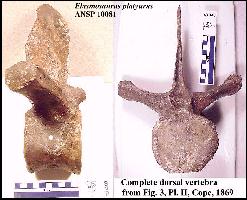 |
LEFT: A complete and nearly perfect dorsal vertebra from the type specimen of Elasmosaurus platyurus Cope 1868.
The centrum measures about 12 cm (5 in.) across. The specimen was found in the
Pierre Shale in what is now western Logan County. RIGHT: The muzzle of
E. platyurus, including the premaxillae and the anterior ends of both dentarys.
This is the largest part of the skull that that was collected by Dr. Theophilus Turner but it is likely that the entire skull
had been preserved and had eroded out prior to discovery. The upper and lower jaws were
found preserved together and were originally illustrated that way by Cope. More recently
they have been separated and can be examined individually. OUTER INNER |
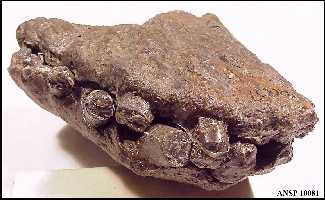 |
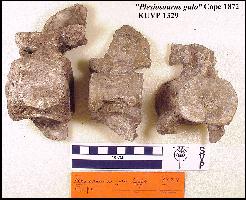 |
LEFT: Three vertebrae (KUVP 1329) from "Plesiosaurus
gulo" Cope 1872 in the University of Kansas collection. (Elasmosauridae
indeterminate) RIGHT: Two dorsal vertebrae (KUVP 129744) recovered from
the Pierre Shale of Logan County in 1991 in association with a 47 gastroliths, some of which were very large. (Probably Elasmosaurus
or Styxosaurus) |
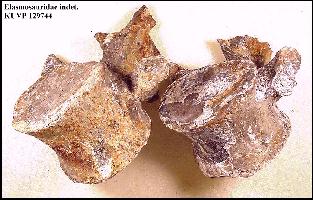 |
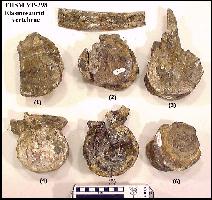 |
LEFT: Six of 7 elasmosaurid vertebrae and a rib fragment (FHSM
VP-398) from the Pierre Shale. The specimen was donated to the Sternberg Museum in 1954 by
R. B. Hooker of Winona, KS. This specimen is probably the same animal as KUVP 129744
(above right) RIGHT: The seventh vertebra of FHSM VP-398,
from the exhibit in the Sternberg Museum of
Natural History. See Everhart (2005b) for a discussion of the possible origin of these
vertebrae. |
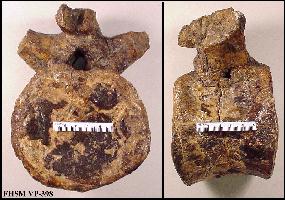 |
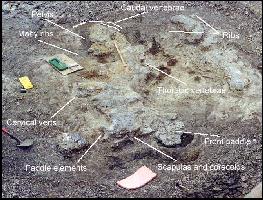 |
LEFT: A partial Styxosaurus
snowii skeleton (CMC 7023) in the the Pierre Shale of Logan County prior to being
removed in 1999. RIGHT: One half of the pelvis of CMC 2023 that was
discovered and first exposed by a dig by the New Jersey State Museum in 1995. |
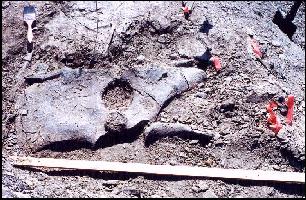 |
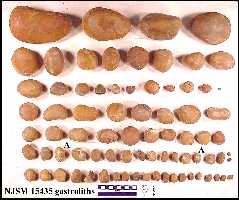 |
LEFT: Gastroliths from NJSM 15435, a large Styxosaurus
snowii from the Pierre Shale of Logan County. This specimen included comminuted fish
bones in the same area where the gastroliths were found (Cicimurri and Everhart,
2001) RIGHT: The distal end of a rear paddle that I uncovered during the dig
of a nearly complete Styxosaurus snowii specimen in
Logan County. The complete paddle was more than 2 m (6 ft.) long. Photo by Barbara
Grandstaff. |
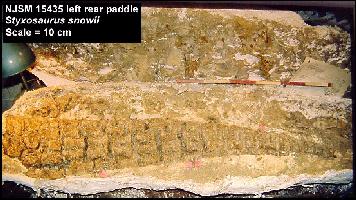 |
 |
LEFT:
The "hip" (a portion of the pelvis and the ball of the femur) of a large Dolichorhynchops
osborni (CMC VP 7055) found by Pam Everhart in a concretion near the top of the
Sharon Springs Member of the Pierre Shale in Logan County in 1992. RIGHT:
The other, "more or less complete" femur (16 in / 40 cm) from the same specimen.
This came from a very large polycotylid plesiosaur, most likely Dolichorhynchops.
|
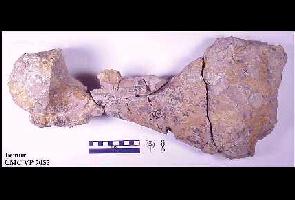 |
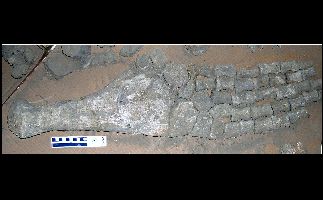 |
LEFT: The front paddle of a large Polycotylus latipinnis
(?) plesiosaur (FHSM VP-16521) collected from the upper Sharon Springs Member of the
Pierre Shale, Logan County, Kansas. RIGHT: An oblique view of the same
paddle and associated remains. (FHSM VP-16521). The specimen consists of a nearly complete
left front paddle, caudal vertebrae, rib fragments and girdle elements, including both
ilia. |
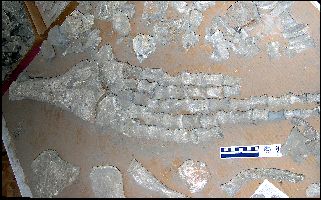 |
LINKS: Styxosaurus Dig 1 Styxosaurus Dig 2 South Dakota Styxosaurus Elasmosaur gastroliths Elasmosaurus
platyurus
Smoky Hill
Chalk - Late Coniacian to Early Campanian: Relatively deep, clear
water, with little disturbance of vertebrate remains. There are only nine elasmosaur
specimens known from the Smoky Hill Chalk in more than 130 years of collecting. Cimoliasaurus
snowii (Williston) was renamed Styxosaurus by Sam Welles in 1943.
(Styx is the mythical river in Hades). The type specimen was found near Hell Creek in
Logan County, Kansas, hence, "Hell Creek lizard" This specimen is
the only elasmosaur skull currently known from the chalk. It was collected by Judge E.P.
West in 1890 and initially described by S.W. Williston (1890). Note that the last bone in
the exhibit is actually an unreported ilium
from the specimen (Everhart, 2006).
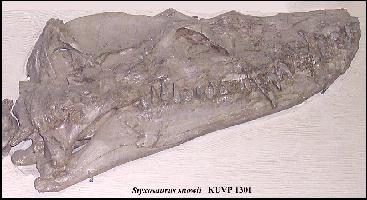 |
LEFT: The skull of the type specimen of Styxosaurus snowii (KUVP 1301) from the
Smoky Hill Chalk of Logan County. RIGHT: KUVP 1300 in a slightly different view
showing some of the 28 cervical vertebrae collected with the specimen. (Larger view here) - (Detail of the attachment of lower jaw to skull)
Note the sclerotic plates within the orbit of the right eye. Go HERE for a labeled drawing of left side
of the skull from Williston (1903). |
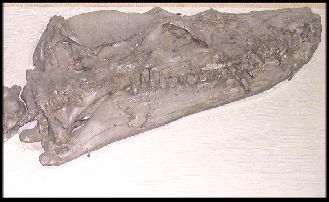 |
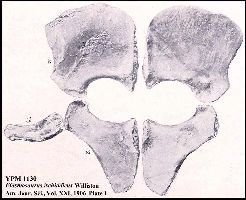 |
LEFT: The pelvis of large elasmosaur (YPM 1130) from the
Smoky Hill Chalk. (now Elasmosauridae indet.) A picture of a similar specimen (KUVP 434)
is HERE. RIGHT: A 1926 photograph by G.
F. Sternberg of the detached left front limb of a juvenile (length about 6 m) elasmosaur
he found south of Oakley, Kansas (Logan County). Recent photo. |
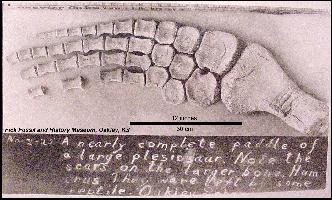 |
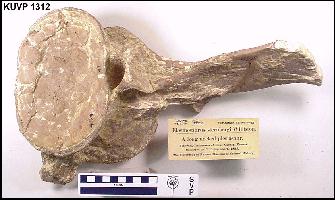 |
LEFT: One of four vertebrae of a very large
elasmosaur (KUVP 1312) collected by Charles H. Sternberg in 1895 from the upper Smoky Hill
Chalk, Logan (not Gove as reported by Williston) County. (Elasmosaurus sternbergi =
Elasmosauridae indet.) RIGHT: Another dorsal vertebrae and ribs of the same
specimen (KUVP 1312, originally numbered as KUVP 433). |
 |
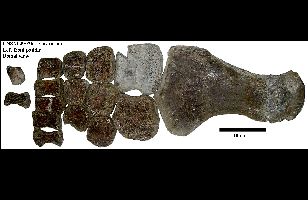 |
LEFT: Detached, partial left front paddle of Styxosaurus
snowii (UNSM 49036) in dorsal view. Collected from the Smoky Hill Chalk of Logan
County, Kansas, around 1910. Note the large, "reversed" and semi-circular
bite mark across the proximal ends of the radius and ulna. It appears that the shark had
detached the paddle from the carcass of the plesiosaur and had taken the upper end into
its mouth in an unsuccessful attempt to bite off a piece that it could swallow. RIGHT:
Detached,
partial left front paddle of Styxosaurus snowii (UNSM 49036) ventral view. There
are many unserrated bite marks on the humerus. Click here for bite marks on
the lower side of the humerus |
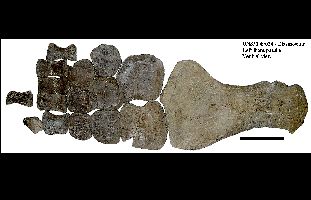 |
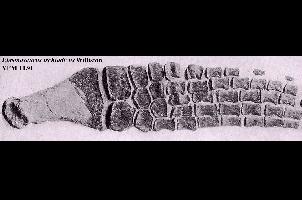 |
LEFT: The right rear paddle of YPM 1130, part of a
specimen found in 1876 by H. A. Brous in Logan County, and named "Elasmosaurus
ischiadicus" by Williston in 1903. (Photograph from Williston, 1906, Pl. II) RIGHT:
The remains of a large shark (Cretoxyrhina mantelli - KUVP 68979) that died with a large number of elasmosaurid (?) gastroliths inside its body
(Trego County). First described by Roy Moodie in 1912. |
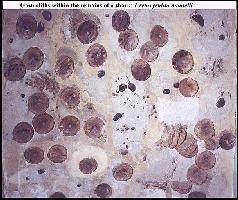 |
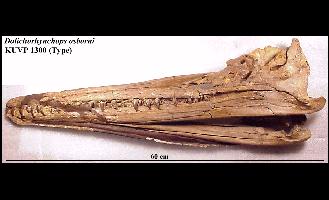 |
LEFT: Left lateral view of the skull of Dolichorhynchops
osborni (KUVP 1300) found by G. F. Sternberg. Click
here for the reconstructed skeleton. RIGHT: An archival
photo of the skeleton of Dolichorhynchops osborni (FHSM VP-404) at the
Sternberg Museum of Natural History, discovered and collected by Marion Bonner. Both
specimens are from Logan County. More about
polycotylids here.
NEW (12/2007) - Detailed photographs of
skull. |
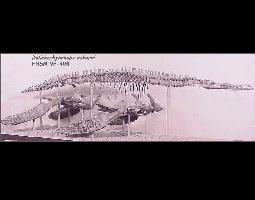 |
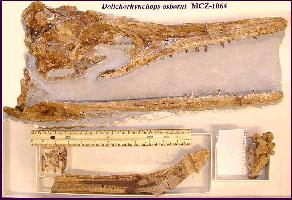 |
LEFT: The skull of Dolichorhynchops osborni
(MCZ 1064) in the collection of the Museum of
Comparative Zoology, Harvard University. Found by G. F. Sternberg in 1926 in Logan
Co. Photo by Charles Schaff, MCZ. RIGHT: A Polycotylus latipinnis
(KUVP 5916) front paddle in the Museum of Natural History at the University of Kansas. The
original photo of this specimen was published in Williston (1903). |
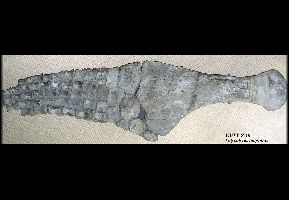 |
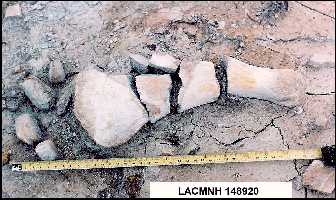 |
LEFT: The propodial (LACMNH 148920) of a Dolichorhynchops
osborni collected from the lower chalk of Lane County in 1990. (Field photo) RIGHT:
Propodials (R to L, PR 617, 618, 619) of juvenile plesiosaurs in the collection of the
Field Museum from the Smoky Hill Chalk. It is likely that these specimens were partially
digested by a large shark. |
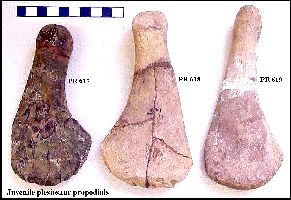 |
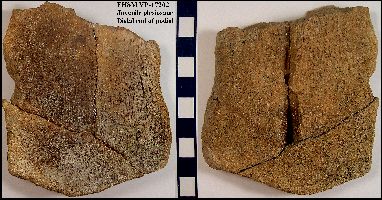 |
LEFT: The distal portion of a juvenile plesiosaur
(probably a polycotylid) from the lower Smoky Hill Chalk in southeastern Gove County. RIGHT: An assortment of juvenile propodials collected by
George Sternberg. Note that these specimens were not associated with any other vertebrate
remains and that the
surface of the bone appears damaged by stomach acids. There is no locality data associated
with these specimens. |
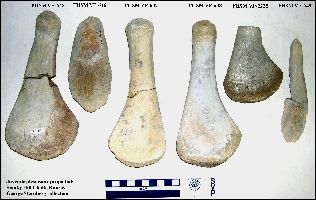 |
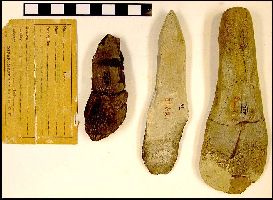 |
LEFT: Three of the juvenile plesiosaur propodials that
were figured by Williston (1903, Plate XXIII -
See also Plate XXII) and Moodie (1911, Plate I). The tag indicates they were
collected by H.T. Martin in Logan County, most likely in the upper Smoky Hill Chalk. RIGHT:
KUVP 1141 in dorsal(?) and ventral(?) views, also figured in Moodie (1911). This specimen
may include a bite mark that appears to have
crushed the edge of the paddle. |
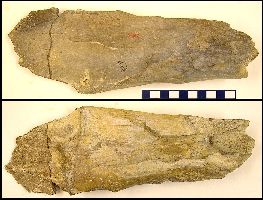 |
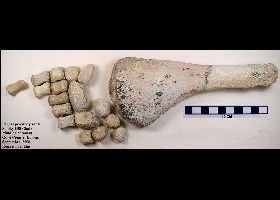 |
LEFT: The remains of a juvenile polycotylid paddle found
in the middle Smoky Hill Chalk by K. Jenkins. The specimen also included a single caudal
vertebra (right), and appears to be partially digested. The correct arrangement of
the epipodials should not be implied from the photograph. (FHSM VP-16868) RIGHT:
A single caudal vertebra associated with the specimen at left. |
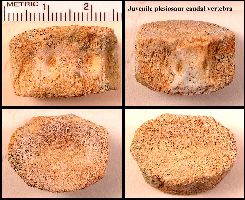 |
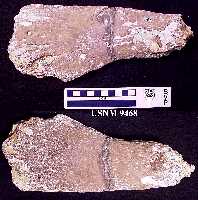 |
LEFT:
Dorsal and ventral views of one of the two polycotylid propodials
(USNM 9468) recovered from inside the rib cage of a Tylosaurus proriger from
the chalk of Logan County, Kansas. Note the corroded (partially digested) appearance.
RIGHT: A ventral view of four
partially digested caudal vertebrae and three caudal ribs. A small gastrolith (arrow)
remains attached to one of the ribs. (Scale = mm) |
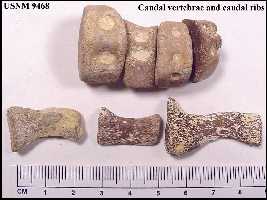 |
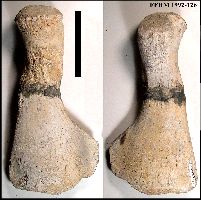 |
LEFT and RIGHT: Dorsal and ventral views of upper
limb bones a polycotylid plesiosaur (FFHM 1992-126) in the collection of the Fick Fossil
and History Museum, Oakley, KS, The humerus at left preserves evidence of scavenging by Squalicorax.
Both specimens were found in Logan County. |
 |
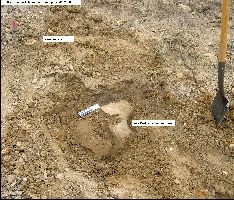 |
LEFT: 2007 field photograph of a polycotylid upper
limb bone that had literally been stomped into the mud by a herd of cattle. You can see a
closer field view HERE and
the distal end of the paddle bone HERE. The
remains were found in the very upper chalk of Logan County, between Marker units 22 and 23 (Lower
Campanian in age). RIGHT:
Several views the distal end of the distal end of the lower jaw of FHSM VP-16869. We will
be looking for the rest of the jaw and the skull early in the 2008 field season. This is
probably the largest polycotylid ever collected from the Smoky Hill Chalk in Kansas. |
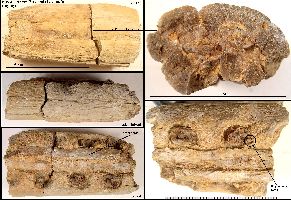 |
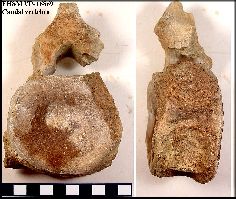 |
LEFT: A dorsal vertebra from the same specimen (FHSM
VP-16869). The remains are probably those of a mature adult Dolichorhynchops osborni. RIGHT:
Photo of several of the vertebrae recovered from this specimen to date. The remains
recovered to date appear to represent parts of a complete animal, so we were hopeful of
recovering more material in 2008. Unfortunately, that wasn't the case. |
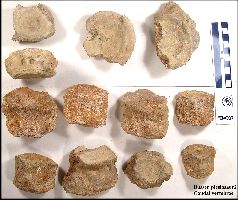 |
The fragmentary specimens shown below are the only known plesiosaur remains from the
lower (Late Coniacian) Smoky Hill Chalk (Everhart, 2003).
They probably represent pieces that were severed from plesiosaur carcasses by large sharks
(Cretoxyrhina mantelli), partially digested and
regurgitated.
Below are some additional plesiosaur "scraps" collected from the
lower Smoky Hill Chalk. All are partially digested remains, probably the result
of scavenging by large sharks. Although they are not identifiable, other than
probably being from a polycotylid, they do document the occurrence of
plesiosaurs in the Western Interior Sea during Late Coniacian time.
 |
LEFT: The distal end of a plesiosaur propodial that I collected in
southern Gove County in 2008.
RIGHT: The remains of a juvenile pliosaur propodial collected
by Mike Triebold in the 1990s. The center portion was missing when the
specimen was discovered. |
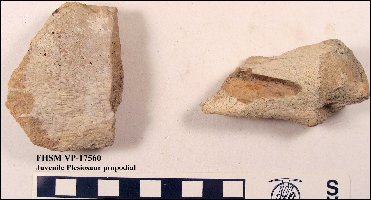 |
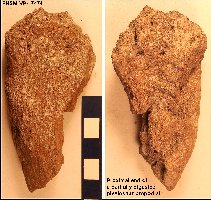 |
LEFT: An almost unrecognizable proximal end of a juvenile
plesiosaur propodial that I collected in the lower Smoky Hill Chalk (below
MU2) in southwestern Trego County.
RIGHT: The most recent plesiosaur specimen (FHSM VP-17709) collected from the lower
Smoky Hill Chalk was discovered and donated by Fred Ackerman in June,
2011. In this case it represents the proximal end of a femur from an adult
plesiosaur that had been swallowed and partially digested by a large
shark. |
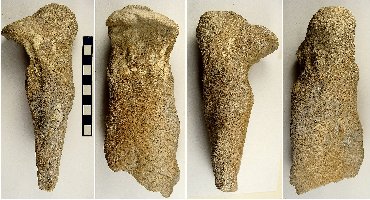 |
LINKS: Mosasaurs ate plesiosaurs
First records of plesiosaurs in the lower Smoky Hill Chalk
Early papers on Elasmosaurus
platyurus.
Fort Hays Limestone (Lower Coniacian):
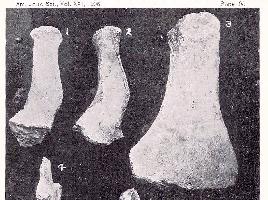 |
LEFT: An early photograph of the remains of YPM 1640, the only
known elasmosaur from the Fort Hays Limestone (Jewell County, KS). Originally named "Elasmosaurus
nobilis" by Williston (1906), this specimen is now considered to be
Elasmosauridae indet. (Storrs, 1999). RIGHT: A recent discovery of a polycotylid
plesiosaur (cf. Dolichorhynchops osborni - FHSM VP-16459) from the basal Fort
Hays Limestone of Jewell County, Kansas. If the identification is correct, this would be
the earliest known occurrence of Dolichorhynchops. The specimen has been donated
to the Sternberg Museum. A close up of two dorsal
vertebrae is here. |
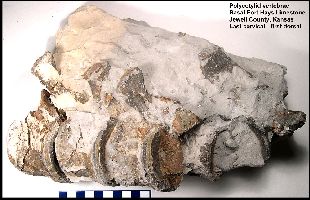 |
Carlile Shale, Greenhorn Limestone and Graneros Shale: The old
"Fort Benton Cretaceous"- Cenomanian to Turonian
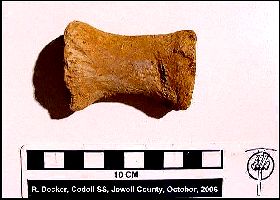 |
LEFT: A fairly large plesiosaur epipodial (paddle/finger bone)
collected in 2006 from the Codell Sandstone member of the Carlile Shale, Jewell County
Kansas. Plesiosaur remains are rare in the Codell Sandstone and over-lying Fort Hays
Limestone. RIGHT: A plesiosaur tooth, most likely from a polycotylid,
collected in 2007 from the Codell Sandstone member of the Carlile Shale, Jewell County
Kansas. |
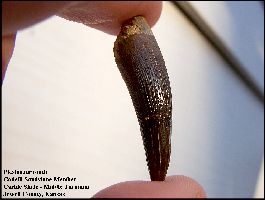 |
 |
LEFT: These fragments of a large plesiosaur rib were collected
from around a broken septarian concretion in the middle Blue Hill Shale Member of the
Carlile Shale near Tipton, Kansas (Mitchell County) in June, 2007. They are upper Middle
Turonian in age. While non-diagnostic, the size of the intact rib head (right) suggests a
large animal, most likely an elasmosaur or pliosaur. However, the specimen (FHSM VP-17299)
is significant because it is only the second set plesiosaur remains ever collected from
the Blue Hill Shale in Kansas. See Everhart (2009). Another more complete specimen
was discovered in 1992 by amateurs (see Schwimmer, Stewart and Williams, 1997 - "FHSM
(unnumbered), p. 79... the site has recently been relocated and the specimen has been
numbered (FHSM VP-17469). New
- Upper and lower views of the
assembled fragments of the plesiosaur rib head.
RIGHT: Most recent plesiosaur specimen FHSM VP-17596) from the
Blue Hill Shale... Fragments of a femur or humerus. |
 |
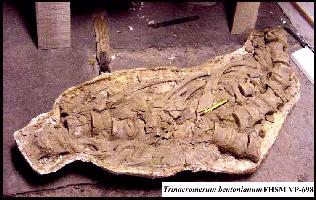 |
LEFT: Part of the remains of a large Trinacromerum bentonianum
(FHSM VP-698) found by George Dreher in Ellis County, Kansas. The specimen was collected
by George Sternberg and M. V. Walker in June, 1956 from the middle of the Fairport Chalk
Member of the Carlile Shale and is Middle Turonian in age. The specimen consists of a 3 m
(10 ft) string of vertebrae, attached ribs and some limb elements. The axis-atlas
vertebrae was included, but the skull was not found. Sternberg's description of this
jacket says; "In the articulated column, this section fits between section 2 and
3. This section contains about 21 continuous vertebrae and a number of ribs. The
section is about 50" long and is the widest and largest section in the series.
Packages #4 and #5 go with the section, also some loose rock slabs with rib
elements." Photo by Bruce Schumacher. |
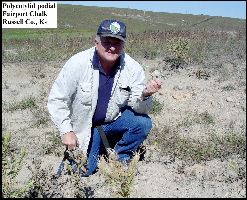 |
LEFT: I'm holding the
proximal end of a small plesiosaur (polycotylid?) humerus that I had just found in the
lower Fairport Chalk Member of the Carlile Shale. (09/2006)--- FHSM VP-16870 RIGHT:
The collection of bone fragments we were able to find at the locality, including both ends of the bone. Photos by Bruce
Schumacher. |
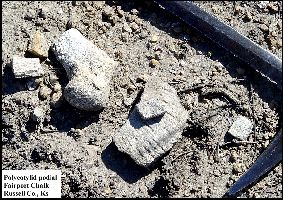 |
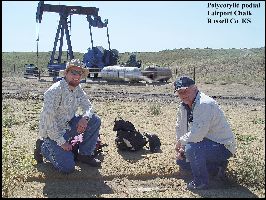 |
LEFT: Fort Hays graduate student Adam Behlke and I kneeling over a
small polycotylid (Trinacromerum bentonianum) paddle recently eroded from the
middle Fairport Chalk near a new oil well in Russell Co., KS (my second plesiosaur
specimen of the day). Photo by Bruce Schumacher. FHSM VP-16871 RIGHT:
A close-up of the partial paddle. When cleaned up, the paddle showed bite marks on the upper shaft. |
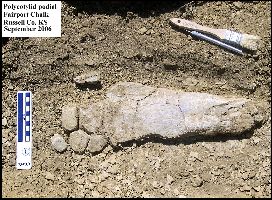 |
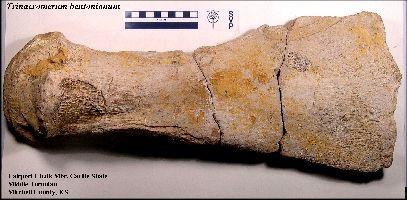 |
LEFT: A large podial, probably the left femur, of Trinacromerum
bentonianum from the Fairport Chalk of Mitchell County, Kansas. (Private Collection).
RIGHT: Part of the right femur from the same specimen, along with a
partial ilium and several caudal vertebrae. Note that the facets for attachment of the
caudal ribs are shared between the vertebrae. This is a distinguishing character of Trinacromerum.
Three isolated podials, probably Trinacromerum, are HERE - This podial exhibits evidence
(bite marks) from scavenging by a large shark. (Private Collection) |
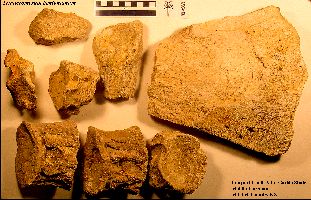 |
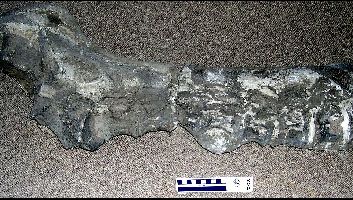 |
LEFT: Part of a Trinacromerum vertebral column in a
limestone concretion from the Carlile Shale Formation of Republic County, Kansas. About 6
to 7 feet of vertebrae were recovered. (Republic County Historical Society) RIGHT:
Same specimen with additional vertebrae. |
 |
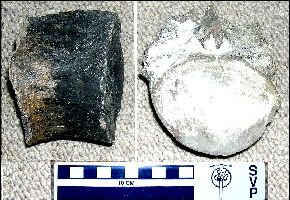 |
LEFT: Two isolated plesiosaur vertebrae from the Carlile Shale
Formation of Republic County, Kansas. (Republic County Historical Society) RIGHT:
Two isolated elasmosaur vertebrae from a sandpit in Republic County, Kansas. (Republic
County Historical Society) |
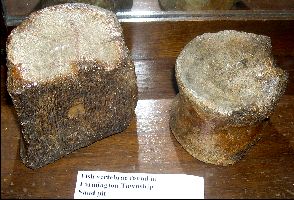 |
 |
LEFT: Right front paddle (length = 1.6 m) from a large, undescribed
elasmosaur (UNSM 1195) found in the Greenhorn Limestone near Holyrood in Ellsworth Co.;
now in the collection of the University of Nebraska State Museum. A older photograph is HERE. L. humerus HERE RIGHT: The
upper portion of the left rear paddle and most of the cervical vertebrae of UNSM 1195. |
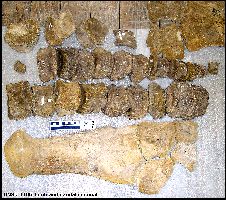 |
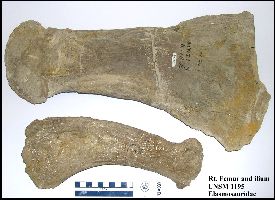 |
LEFT: The right femur and ilium of UNSM 1195. This specimen
is probably the most complete elasmosaur ever collected from Kansas but it has not yet
been described. RIGHT: Three views of a dorsal vertebra
from UNSM 1195. Most of the vertebral column and limbs were recovered with the
specimen. Posterior cervicals HERE Caudal vertebrae HERE. See Everhart (2007) for
re-discovered locality. |
 |
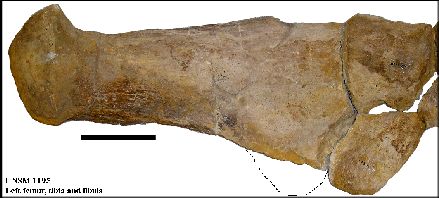 |
LEFT: The left femur, tibia and fibula of UNSM 1195. Dotted line
indicates missing posterior edge of the femur. RIGHT: Photograph by
George F. Sternberg (circa 1935) of three of the paddles, an ilium, some vertebrae,
gastroliths and two teeth found in association (University of Nebraska State Museum
archives). |
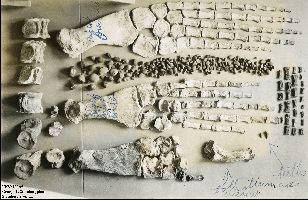 |
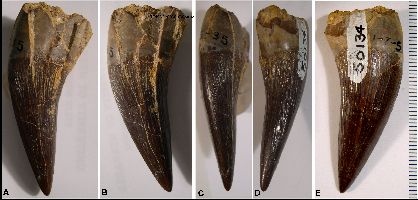 |
LEFT: The larger of the two plesiosaur teeth collected with the
specimen. The skull was not found. Another view of the two teeth found in association with the specimen is
HERE. RIGHT: This picture shows the 240 (2.2 kg) of gastroliths found in
association with UNSM 1195. |
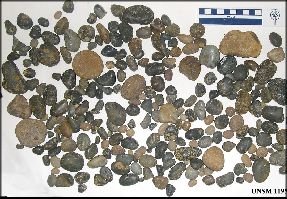 |
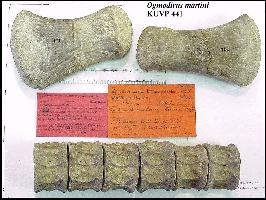 |
LEFT: Part of the remains of "Ogmodirus
martini" Williston and Moodie (1913) from Cloud County, Kansas.
(Elasmosauridae indet.) RIGHT: A close up of one of the propodials (humerus or
femur) of Ogmodirus martini showing evidence of
scavenging by Squalicorax falcatus (serrated bite marks). |
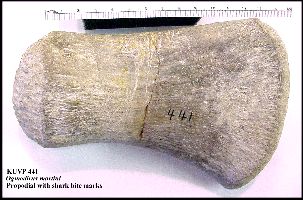 |
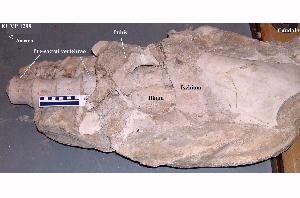 |
LEFT: A concretion (KUVP 1299) containing a partial pelvis and 13
vertebrae of a small elasmosaur (?) from Ellsworth County. (Length = 90 cm). RIGHT:
A closer view of the ventral side of the most anterior dorsal vertebrae of this specimen
(KUVP 1299). |
 |
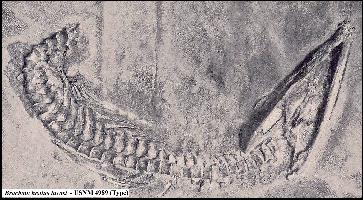 |
LEFT: An early photograph in ventral view of the type specimen of
Brachauchenius lucasi Williston (USNM 4989) in the United States National Museum
(Smithsonian). RIGHT: A recent photograph of the same specimen. The remains
were found in Ottawa County about 1884 and acquired by the Smithsonian from Charles
Sternberg. (See Everhart, 2007) |
 |
 |
LEFT: The skull of Brachauchenius lucasi
(FHSM VP-321) in the Sternberg Museum of Natural History. The skull is 1.5 m (5 ft.) in
length and was found in Russell County in 1950. RIGHT: One of the teeth of
the FHSM VP-321 Brachauchenius
lucasi specimen (scale = mm). Here is a crushed
tooth that I collected (10/2006)from the basal Lincoln Member of the Greenhorn
Limestone. |
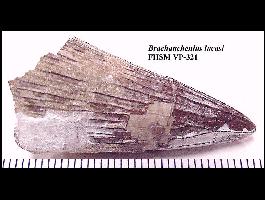 |
 |
LEFT: The front portion of the skull of a cf. Brachauchenius lucasi
(UNSM 50136) specimen from an unknown locality in Kansas. This specimen is even larger in
size than FHSM VP-321 (above). Bruce Schumacher assembled the pieces into the front
2/3s of a large skull... HERE RIGHT:
A portion of the skull and a jaw with teeth of a Brachauchenius lucasi specimen
(UNSM 112437) from Mitchell County discovered in the Graneros Shale during the
construction of the Glen Elder Dam. Possibly the oldest known specimen of this species.
(Both specimens in the collection of the University of Nebraska State Museum) |
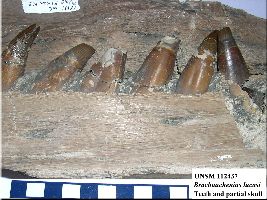 |
 |
LEFT: The paratype specimen of Trinacromerum bentonianum Cragin
(USNM 10946) in the United
States National Museum (Smithsonian). This specimen was found near Downs in Osborne County
about 1891. RIGHT: A skull (KUVP 5070) discovered in
1936 in the Hartland Shale, south of Concordia (Cloud County), KS, and originally
described as the type of "Trinacromerum willistoni" by Riggs (1944). The
name is now considered to be a junior synonym of T. bentonianum (Carpenter, 1996). The specimen consists of a complete skull with mandible, fifty vertebrae
(fifteen cervicals including the atlas-axis), ribs, most of the pectoral girdle, both
pubes and the ischia (Riggs, 1944), and is Late Cenomanian in age. |
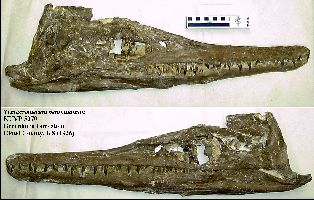 |
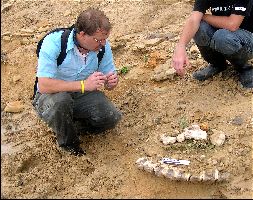 |
LEFT:
August, 2008 - Bruce Schumacher looks an articulated series of Trinacromerum
bentonianum cervical vertebrae discovered in the upper Greenhorn Limestone of Russell
County. Shortly after this picture was taken, he located the six anterior-most cervical
vertebrae just to the left of his left knee. A total of 26 vertebrae and a rib fragment
were collected (FHSM VP17471). RIGHT: A close up of the
vertebrae, showing 8 that are still in situ and 12 others that had already washed out. |
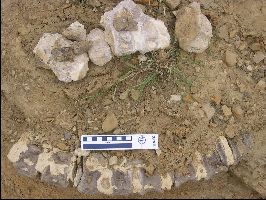 |
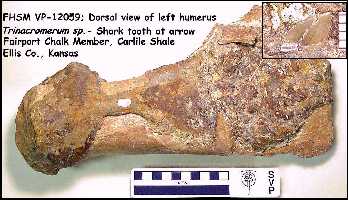 |
LEFT: A
dorsal view of the left humerus of a Trinacromerum bentonianum (FHSM VP-12059) in
the Sternberg Museum collection, with an associated Squalicorax falcatus tooth
(inset). (Another bone here) RIGHT:
KUVP 1325 was one of the
first plesiosaur fossils found in the "Fort Benton Cretaceous." It was originally identified (1873) by B.F. Mudge as
"Ichthyosaurus," and was described as "Trinacromerum anonymum"
by Williston (1903). |
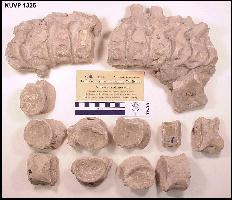 |
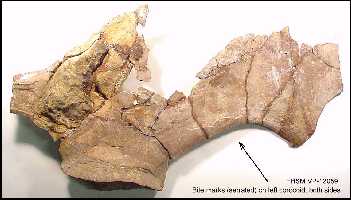 |
LEFT: Squalicorax hark bite marks
on both sides of the left coracoid of VP-12059. (Fairport Chalk, Ellis County, KS) RIGHT:
Two of many
vertebrae (KUVP 1331) of a Trinacromerum bentonianum specimen found in 1921 while
cleaning a spring in Lincoln County. |
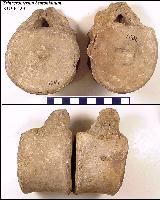 |
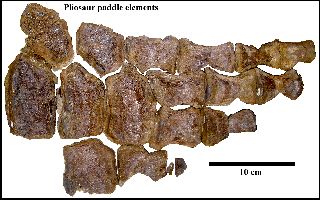 |
LEFT: A portion of the paddle of a large pliosaur (FHSM VP-13997) from
the basal Lincoln Limestone Member of the Greenhorn Limestone (Middle Cenomanian), Russell
County, KS. The bones would have come from a paddle that was about 2 m (6.5 ft) in
length, and a pliosaur that was about 25 feet long. RIGHT: A large
tooth of Brachauchenius lucasi (FHSM VP_17957) collected by
Irene Lott of Blue Rapids, from a quarry west of Haddam, Kansas (eastern
Republic County). This is the eastern most known occurrence of this giant
pliosaur. |
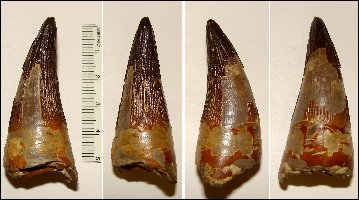 |
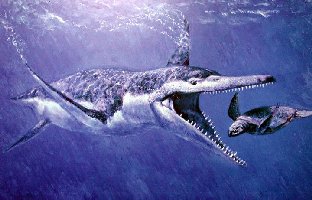 |
LEFT and RIGHT: Dan Varner's paintings
of the pliosaur, Brachauchenius lucasi, from the Late
Cretaceous of Kansas. |
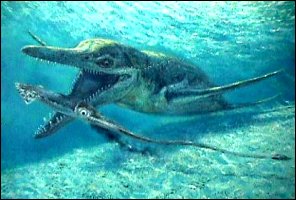 |
Graneros Shale:
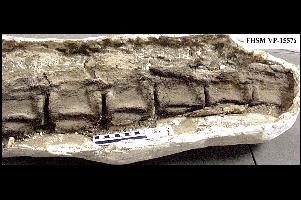 |
LEFT: A series of elasmosaurid cervical vertebrae (FHSM VP-15576)
collected from the Graneros Shale of Ellis County by Orville Bonner in 1962. This the only
known plesiosaur material from the Graneros in Kansas. RIGHT: The
skull of Thalassomedon haningtoni (UNSM 50132) in the collection of the University of Nebraska State Museum from the Graneros Shale of
southeastern Nebraska (NOT Kansas). Another complete specimen of this species was found in
the Graneros Shale of southeastern Colorado (DMNH 1588) |
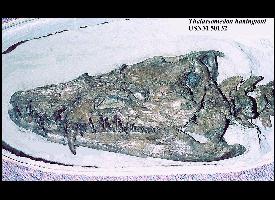 |
Dakota Sandstone - Sand and clays deposited by a large
river or rivers flowing into the Western Interior Sea from the northeast.
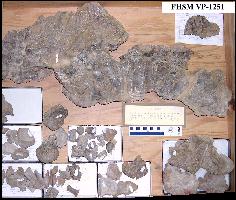 |
LEFT: A drawer in the collection of the Sternberg Museum containing
plesiosaur remains (FHSM VP-2151) collected from the Dakota Sandstone of Stanton County in
southwest Kansas. This specimen represents the earliest Late Cretaceous plesiosaur remains
found in Kansas. RIGHT: A close-up of the sandstone block with the impressions of
the plesiosaur vertebrae (FHSM VP-2151). Most of the bone had been eroded away prior to
discovery. |
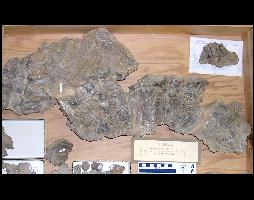 |
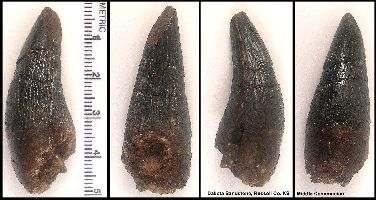 |
LEFT: A large pliosaur tooth (FHSM VP-17568 - cf. Brachauchenius lucasi)
collected by Keith Ewell from the upper Dakota Sandstone of Russell County. Note the large
wear facet at the tip of the tooth. If this is a Brachauchenius tooth, it would
the earliest report of the species in Kansas. |
Kiowa Shale (Early Cretaceous - Upper Albian) - Near
shore, high energy environment that tore apart most skeletons before burial. There are
over 150 plesiosaur specimens known from the Kiowa Shale. Unfortunately, most consist of a
single bone.
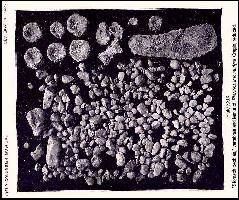 |
LEFT: An old photograph of the remains of a specimen of "Plesiosaurus
mudgei" Cragin (KUVP 1305 - now considered to be a nomen dubium) from the Kiowa
Shale of Clark County, including over 200 gastroliths. Collected by C. N. Gould in 1893,
the specimen cannot be relocated. Similar
stones are found in the lower Kiowa Shale and are interpreted as "probable"
gastroliths: See also this field photo RIGHT:
A more recently collected (1962 by M.V. Walker) set of plesiosaur remains (FHSM VP-2170)
from the Kiowa Shale of Clark County. One of
the lower limb bones of this specimen appears to preserve a large bite mark (Pliosaur or
crocodile), Similar remains have been collected from the Kiowa Shale in Kiowa and
McPherson counties. |
 |
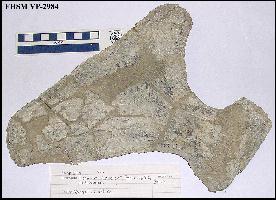 |
LEFT: A portion of the pelvis (ischium) of a plesiosaur (FHSM VP-2984)
from the Kiowa Shale of Clark County. Right: A propodial of a plesiosaur (FHSM
VP-2983) from the Kiowa Shale of Clark County. |
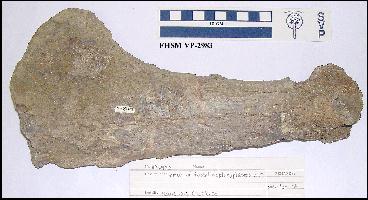 |
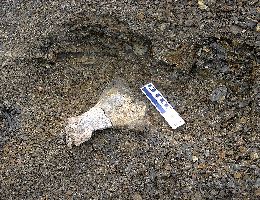 |
LEFT: The left ischium of a small plesiosaur discovered in the basal
Kiowa Shale (Albian) of Kiowa County, Kansas, August, 2008. (FHSM VP-17302) RIGHT:
Dorsal and ventral views of the ischium after preparation and putting it back together. The ischium is about 20 cm in length
and would scale up to a plesiosaur that was about 3.3 m long, assuming it was
something like Plesiosaurus.
Dorsal and ventral views of the
same bone after preliminary preparation.
Click here for an
interpretation of this element. |
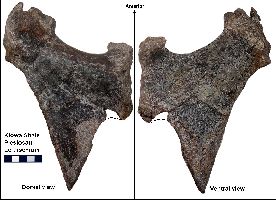 |
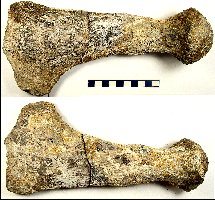 |
In late June, 2011, Ken Brunson and I prospected some
exposures in the lower Kiowa Formation near Belvidere, Kansas
(Kiowa County). Although we didn't find much initially, about noon we
walked into an area that was pretty rich in plesiosaur remains....
LEFT: FHSM VP-17708 - A complete propodial (probably a right femur) that I found
eroding in a gully. The distal end had broken off and slid downslope where
I saw it.... the proximal end
was still embedded in the shale. ... and another with me
holding the specimen (Photos by Ken Brunson)
RIGHT: Then Ken
discovered this vertebra sitting on top of the shale in the next exposure.
I was about two steps behind him.... Side
view here. The centrum is about 4 cm across and 3.5 cm in
length. (FHSM VP-17711) |
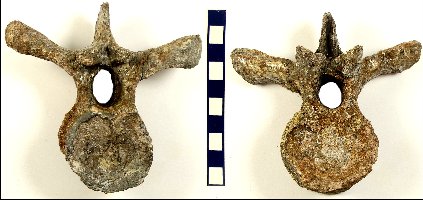 |
 |
LEFT: A few minutes later and near the first vertebra, I
picked up what looked like an odd piece of rock. As I looked l closer, I
could see that it was actually cancellous (spongy) bone...probably part of
a plesiosaur limb that had been either partially digested by a shark, or
just badly preserved. See
group photo here.
RIGHT: FHSM VP-17710 - A few meters to the south and at a slightly lower level, I
saw this vertebra lying out on the surface. Further downslope
there was a piece of eroded bone that I assume was the missing dorsal
process from this vertebrae. The lateral processes are very robust on this
specimen so I'm assuming that this is one of the sacral vertebra.
This time Ken was behind me.... LOL Note the differences in the locations
of the lateral processes between this and the vertebra above. These
and other clues allow to roughly place the vertebrae in the animal's spine
with reasonable accuracy. |
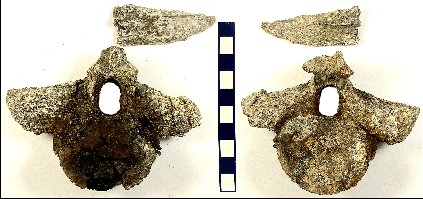 |
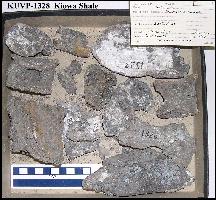 |
LEFT: A box of plesiosaur "scraps" (KUVP 1328), including
several vertebrae collected from the Kiowa Shale of Clark County by C. N. Gould in 1894. RIGHT:
The posterior part of a plesiosaur jaw (FHSM VP-2985) collected from the Kiowa Shale of
Clark County. Given the large size, it is most likely from a pliosaur
like Brachauchenius. |
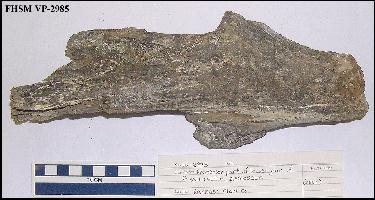 |
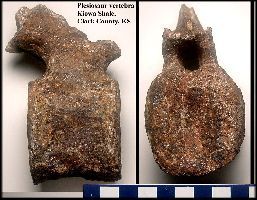 |
LEFT: Four views of a recently collected (2006) plesiosaur
vertebra (FHSM VP-16386) from the Kiowa Shale of Clark County. RIGHT: Two views
of a single cervical vertebra (KUVP 16215) from the Kiowa Shale of Clark County. |
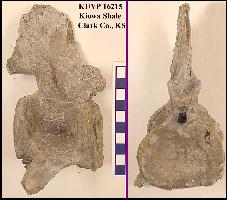 |
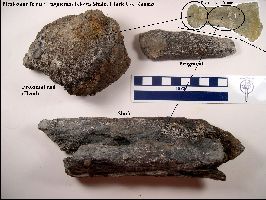 |
LEFT: A fragmented and badly weathered podial of a large
plesiosaur from Clark County. (FHSM VP-17300) RIGHT: Close up of the
specimen at left, showing the bone texture. |
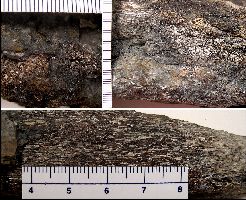 |
 |
LEFT: Part of a series of more than 15 articulated cervical
vertebrae (KUVP 16375) from small plesiosaur collected in Clark County by Bonner and
Williams.
RIGHT: The articular portion from the back of the jaw of a large plesiosaur (KUVP
85289) from the Kiowa Shale, Clark Co., Kansas.
|
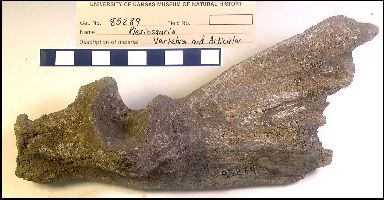 |
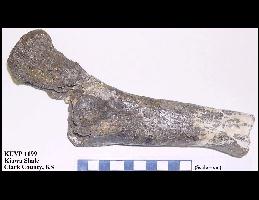 |
LEFT: The proximal end of an unusual bone (KUVP 1199) collected
by S. W. Williston from the Kiowa Shale (Clark County) in 1893. Originally thought to be
the femur of a crocodile, Williston (1903) later described it as a new species of giant
pterosaur ("Apatomerus mirus"). It is most likely the upper end of a
plesiosaur propodial. RIGHT: The upper portion of a similar plesiosaur propodial
(KUVP 16216) collected from the Kiowa Shale of Clark County. |
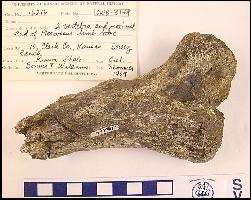 |
Suggested references regarding Kansas plesiosaurs:
Adams, D. A., 1997. Trinacromerum bonneri, new species, last and fastest
pliosaur of the Western Interior Seaway. Texas Journal of Science, 49(3):179-198.
Almy, K. J. 1987. Thof’s dragon and the letters of Capt.
Theophilus Turner, M.D., U.S. Army, Kansas History Magazine, 10(3):170-200.
(Background on the discovery of Elasmosaurus platyurus, Cope’s "head on
the wrong end" plesiosaur - historical)
Bonner, O.W. 1964. An osteological study of Nyctosaurus and Trinacromerum
with a description of a new species of Nyctosaurus, Unpub. Masters
Thesis, Fort Hays State University, 63 pages.
Brown, B. 1904. Stomach stones and the food of
plesiosaurs. Science, 20(501):184-185. (Gastroliths mixed with stomach contents in
plesiosaurs)
Carpenter, K. 1994. Comparative cranial anatomy of two North American
plesiosaurs (Reptilia: Sauropterygia) and a review of some North American elasmosaurs,
unpublished draft.
Carpenter, K. 1996. A review of short-necked plesiosaurs from the
Cretaceous of the Western Interior, North America, Neues Jahrbuch für Geologie und
Paläeontologie Abhandlungen, (Stuttgart) 201(2):259-287.
Carpenter, K. 1997. Comparative cranial anatomy of two North American
Cretaceous plesiosaurs, In Calloway J. M. and Nicholls, E. L., eds, Ancient
Marine Reptiles, Academic Press, pp. 191-216
Carpenter, K. 1999. Revision of North American Elasmosaurs from the Cretaceous
of the Western Interior, Paludicola, 2(2):148-173.
Cicimurri, D.J. and M.J. Everhart. 2001. An elasmosaur with stomach contents and
gastroliths from the Pierre Shale (late Cretaceous) of
Kansas. Kansas Acad. Sci. Trans 104(3-4):129-143.
Cope, E.D. 1868. Remarks on a new enaliosaurian, Elasmosaurus
platyurus. Proceedings of the Academy of Natural Sciences of Philadelphia
20:92-93. (for meeting of March 24, 1868)
Cope, E.D. 1868. [On new species of extinct reptiles]. Proceedings of the
Academy of Natural Sciences of Philadelphia 20:181. (for meeting of July 14, 1868.
Cope, E.D. 1868. On some Cretaceous reptilia. Proceedings of the Academy of
Natural Sciences of Philadelphia 20:233-242. (for meeting of Oct. 27, 1868)
Cope, E.D. 1868. (A resolution thanking Dr. Theophilus
Turner for his donation of the skeleton of Elasmosaurus platyurus). Proceedings
of the Academy of Natural Sciences of Philadelphia 20:314
.
Cope, E.D. 1870. On Elasmosaurus platyurus Cope.
American Journal of Science, ser. 2, 50(148):140-141.
Cope, E.D. 1870. Additional note on Elasmosaurus.
American Journal of Science, ser. 2, 50(149):268-269.
Cope, E.D. 1870. Extinct Batrachia, Reptilia and Aves of North
America. Transactions of the American Philosophical Society. New Series 14:1-253.
Cope, E. D. 1870. Remarks on fossil
reptiles from the Cretaceous of Kansas. Proceedings of the Academy of Natural
Sciences of Philadelphia, p. 132. (Polycotylus latipinnis)
Cragin, F.W. 1888. Preliminary description of a new or little known saurian
from the Benton of Kansas, American Geologist 2:404-407. <EM>
Cragin, F.W. 1891. New observations on the genus Trinacromerum.
American Geologist 8:171-174.
Cragin, F.W. 1894. Vertebrata from the Neocomian of Kansas. Colorado College
Studies v pp. 69-73, pls. i, ii.
Darby, D.G. and R.W. Ojakangas. 1980. Gastroliths from an Upper
Cretaceous plesiosaur, Journal of Paleontology, 54(3):548-556.
Everhart, M.J. 2000. Gastroliths associated
with plesiosaur remains in the Sharon Springs Member of the Pierre Shale (late
Cretaceous), Western Kansas. Kansas Acad. Sci. Trans. 103(1-2):58-69.
Everhart, M. J. 2002. Where the
elasmosaurs roam...... Prehistoric Times. 53:24-27.
Everhart, M.J. 2003. First records of
plesiosaur remains in the lower Smoky Hill Chalk Member (Upper Coniacian) of the Niobrara
Formation in western Kansas. Kansas Academy of Science, Transactions 106(3-4):139-148.
Everhart, M.J. 2004. New data regarding the skull of Dolichorhynchops
osborni (Plesiosauroidea: Polycotylidae) from rediscovered photos of the Harvard
Museum of Comparative Zoology specimen. Paludicola 4(3):74-80.
Everhart, M.J. 2004. Plesiosaurs as the food of mosasaurs;
new data on the stomach contents of a Tylosaurus proriger (Squamata;
Mosasauridae) from the Niobrara Formation of western Kansas. The Mosasaur 7:41-46.
Everhart, M.J. 2005. Probable plesiosaur gastroliths from the basal Kiowa Shale (Early
Cretaceous) of Kiowa County, Kansas. Kansas Academy of Science, Transactions 108 (3/4):
109-115.
Everhart, M.J. 2005. Bite marks on an elasmosaur (Sauropterygia; Plesiosauria)
paddle from the Niobrara Chalk (Upper Cretaceous) as probable evidence of feeding by the
lamniform shark, Cretoxyrhina mantelli. PalArch, Vertebrate paleontology
2(2): 14-24.
Everhart, M.J. 2005. Elasmosaurid remains from the Pierre Shale (Upper Cretaceous) of
western Kansas. Possible missing elements of the type specimen of Elasmosaurus
platyurus Cope 1868? PalArch 4(3): 19-32.
Everhart, M.J. 2006. The occurrence of elasmosaurids (Reptilia: Plesiosauria)
in the Niobrara Chalk of western Kansas. Paludicola 5(4):170-183.
Everhart, M.J. 2007. Use of archival photographs to rediscover the
locality of the Holyrood elasmosaur (Ellsworth County, Kansas). Kansas Academy of Science, Transactions
110(1/2): 135-143.
Everhart, M.J. 2007. Historical note on the 1884
discovery of Brachauchenius lucasi (Plesiosauria; Pliosauridae) in Ottawa County,
Kansas. Kansas Academy of Science, Transactions 110(3-4):255-258.
Everhart, M.J. 2009. Probable plesiosaur remains from the Blue Hill Shale
(Carlile Formation; Middle Turonian) of north central Kansas. Kansas Academy of Science,
Transactions 112(3/4):215-221.
Hawkins, T. 1834. Memoirs of
ichthyosauri and plesiosauri, extinct monsters of the ancient Earth. Roy. fol.,
London. ix + 58 pp., frontisp., 28 pls.
Henderson,
D.M. 2006. Floating point: a computational study of buoyancy, equilibrium, and gastroliths
in plesiosaurs. Lethaia 39:227-244.
Kubo, T., Mitchell, M.T. and Henderson, D.M.
2012. Albertonectes vanderveldei, a new elasmosaur (Reptilia,
Sauropterygia) from the Upper Cretaceous of Alberta. Journal of Vertebrate
Paleontology 32(3):557-572.
Lane, H.H. 1946. A survey of the fossil vertebrates of Kansas, Part III, The
Reptiles. Kansas Academy Science, Transactions 49(3):289-332, 7 figs.
Leidy, J. 1870. (Remarks on Elasmosaurus platyurus).
Proceedings of the Academy of Natural Sciences of Philadelphia22:9-10.
(for meeting of March 8, 1870)
Leidy, J. 1870. On the Elasmosaurus platyurus
of Cope. American Journal of Science, Series 2, 49(147):392.
Martin, J.E. and L.E. Kennedy. 1988. A plesiosaur from the late Cretaceous
(Campanian) Pierre Shale of South Dakota: A Preliminary Report, Proc. S.D. Acad. Sci.,
67:76-79
Moodie, R.L. 1911. An embryonic plesiosaurian propodial. Kansas Academy
Science, Transactions 23:95-101, 9 figs, 1 pl.
Mudge, B.F. 1877. Notes on the Tertiary and Cretaceous periods of Kansas. pp.
277-294, in Part I (Geology) of the Ninth Annual Report, U. S. Geological and
Geographical Survey Territories (Hayden), for 1875, 827 p.
Owen, R. 1860. Palaeontology, or a systematic summary of extinct animals and
their geological relations. Adam and Charles Black, Edinburgh, xv +420 p. 142 text figs.
(1st edition).
Riggs, E.S. 1939. A specimen of Elasmosaurus serpentinus, Field Museum
of Natural History, Geology, 6:385-391.
Riggs, E.S. 1944. A new polycotylid plesiosaur. University of Kansas Science
Bulletin 30:77-87.
Russell, D.A. 1988. A check list of North American marine cretaceous
vertebrates including fresh water fishes, Occasional Paper of the Tyrrell Museum of
Palaeontology (4):57.
Sanders, F., K. Carpenter, B. Reed and J. Reed. 2004. Plesiosaur swimming
reconstructed from
skeletal analysis and experimental results. Journal of
Vertebrate Paleontology 24. (Abstract)
Shuler, E.W. 1950. A new elasmosaur from the Eagle Ford Shale of
Texas. Part II. Fondren Science Series V1, #2, 1-33 pp. 26 figs.
Shuler, E.W. and S.P. Welles. 1947. New elasmosaur from the
Upper Cretaceous of Texas. Bulletin Geological Society of America 58:1263.
Schultze, H.-P., L. Hunt, J. Chorn and A.M. Neuner. 1985. Type and figured
specimens of fossil vertebrates in the collection of the University of Kansas Museum of
Natural History, Part II. Fossil Amphibians and Reptiles. Miscellaneous Publications of
the University of Kansas Museum of Natural History 77:66 pp.
Schumacher, B.A. 2008. On the skull of a pliosaur (Plesiosauria; Pliosauridae) from the
Upper Cretaceous (Early Turonian) of the North American Western Interior. Kansas Academy
of Science, Transactions 111(3-4):203-218.
Schumacher, B.A. and M.J. Everhart. 2005. A stratigraphic and
taxonomic review of plesiosaurs from the old “Fort Benton Group” of central
Kansas: A new assessment of old records. Paludicola 5(2):33-54.
Schwimmer, D. R., J. D. Stewart, and G. D. Williams, 1997. Scavenging by sharks of the
genus Squalicorax in the late Cretaceous of North America, PALAIOS, 12:71-83.
Sternberg, C.H. 1917 (1932). Hunting Dinosaurs in the Badlands
of the Red Deer River, Alberta, Canada. Published by the author, San Diego, Calif.,
261 pp. (Reference to elasmosaurs, incl. note on p. 166 about the discovery of KUVP 1312,
the type specimen of Elasmosaurus sternbergi)
Sternberg, G.F. and M.V. Walker. 1957. Report on a
plesiosaur skeleton from western Kansas. Kansas Academy of Science, Transactions,
60(1):86-87.
Storrs, G.W. 1981. A review of occurrences of the Plesiosauria (Reptilia:
Sauropterygia) in Texas with description of new material. Masters Thesis, The University
of Texas at Austin, 226 pages.
Storrs, G.W. 1984. Elasmosaurus platyurus and a page from the Cope-Marsh
war. Discovery 17(2):25-27.
Storrs, G.W. 1997. Morphological and taxonomic clarification of the genus
Plesiosaurus. pp. 145-190, In Calloway, J. M. and Nicholls, E. L., eds, Ancient
Marine Reptiles, Academic Press.
Storrs, G.W. 1999. An examination of Plesiosauria (Diapsida: Sauropterygia)
from the Niobrara Chalk (upper Cretaceous) of central North America. The University of
Kansas Paleontological Contributions, (N. S.), No. 11, 15 pp.
Taylor, M.A. 1993. Stomach stones for feeding or buoyancy? The occurrence and
function of gastroliths in marine tetrapods. Philosophical Transactions of the Royal
Society of London. B 341:163-175.
Taylor, M.A. 1994. Stone, bone or blubber? Buoyancy control strategies in
aquatic tetrapods. pp.151-161, In Maddock, L., Bone, Q., and Rayner, J. M. V.
(ed.), Mechanics and Physiology of Animal Swimming, Cambridge University Press,
Welles, S.P. 1943. Elasmosaurid plesiosaurs with a description of the new
material from California and Colorado. University of California Memoirs 13:125-254.
figs.1-37., pls.12-29.
Welles, S.P. 1949. A new elasmosaur from the Eagle Ford Shale of Texas. Fondren
Science Series, Southern Methodist University, 1:1-28
Welles, S.P. 1952. A review of the North American Cretaceous elasmosaurs.
University of California Publications in Geological Sciences. 29:46-144. figs. 1-25.
Welles, S.P. and J. Bump. 1949. Alzadasaurus pembertoni, a new
elasmosaur from the Upper Cretaceous of South Dakota. Journal of Paleontology,
23(5):521-535.
Williston, S.W. 1890. A new plesiosaur from the Niobrara
Cretaceous of Kansas. Kansas Academy Science, Transactions 7:174-178,
with 2 fig.
Williston, S.W. 1890. Structure of the
plesiosaurian skull. Science 16(407):290. (Discusses features of the skull and
turtles)
Williston, S.W. 1893. An interesting food habit of
the plesiosaurs. Kansas Academy of Science, Transactions 13:121-122, 1 plate.
(Gastroliths)
Williston, S.W. 1894. On various vertebrate remains from the lowermost
Cretaceous of Kansas. Kansas University Quarterly 3(1):1-4, pl. I.
Williston, S.W. 1897. A new plesiosaur from the Kansas Comanche Cretaceous.
Kansas University Quarterly 4:57.
Williston, S.W. 1902. Restoration of Dolichorhynchops osborni, a new
Cretaceous plesiosaur, Kansas University Science Bulletin,
1(9):241-244, 1 plate.
Williston, S.W. 1903. On the osteology of Nyctosaurus (Nyctodactylus),
with notes on American pterosaurs. Field Museum Publications (Geological
Series ) 2(3):125-163, 2 figs., pls. XL-XLIV. (includes description of Apatomerus mirus)
Williston, S.W. 1903. North American Plesiosaurs. Field Columbian Museum, Pub.
73, Geological Series, 2(1):1-79, 29 plates.
Williston, S.W. 1904. The stomach stones of the
plesiosaurs. Science (new series) 22:565.
Williston, S.W. 1906. North American Plesiosaurs: Elasmosaurus,
Cimoliasaurus, and Polycotylus. American Journal of Science, 4(21):221-236.
Williston, S.W. 1907. The skull of Brachauchenius, with special
observations on the relationships of the plesiosaurs. United States National Museum
Proceedings 32:477-489. pls. 34-37.
Williston, S.W. 1908. North American Plesiosaurs: Trinacromerum.
Journal of Geology 16:715-735. figs. 1-15.
Williston, S.W. 1914. Water Reptiles of the Past and Present. Chicago
University Press. 251 pp. (Free,
downloadable .pdf version here)
Williston, S.W. and R.L. Moodie.
1913. New
plesiosaurian genus from the Cretaceous of Nebraska. Bulletin of the Geological Society of America 24:
120-121. (Abstract reporting Ogmodirus martini - note original spelling -
and also note that it was from Kansas, not Nebraska)
Williston, S.W. and R.L. Moodie. 1917. Ogmodirus martinii, a new
plesiosaur from the Cretaceous of Kansas. Kansas University Science Bulletin 10:61-73,
figs. 1-3., plates 1-5.














































